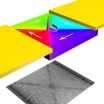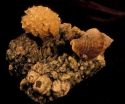(Press-News.org) University of Rochester Medical Center scientists believe they are the first to identify genes that underlie the growth of primitive leukemia stem cells, and then to use the new genetic signature to identify currently available drugs that selectively target the rogue cells.
Although it is too early to attach significance to the drug candidates, two possible matches popped up: A drug in development for breast cancer (not approved by the Food and Drug Administration), and another experimental agent that, coincidentally, had been identified earlier by a URMC laboratory as an agent that targets leukemia cells.
The research not only provides a better understanding of the basic biology of leukemia – it uncovered genes not previously known to be associated with the disease -- but demonstrates a powerful strategy for drug discovery, said senior investigator Craig T. Jordan, Ph.D., the Philip and Marilyn Wehrheim professor of Medicine at URMC and the James P. Wilmot Cancer Center.
First author John Ashton, PhD, led the study, which was published this month in the journal Cell Stem Cell.
"Our work is both basic and translational, and is an example of a terrific collaboration," Jordan said. "We were able to use the latest technology to expand very strong basic laboratory concepts and conduct an intriguing analysis that may yield new insights for treatments of leukemia."
Jordan studies leukemia stem cells, which, unlike normal cells, renew uncontrollably and are believed to be the first cells at the root of malignancy. He collaborated with Hartmut (Hucky) Land, Ph.D. and Helene McMurray, Ph.D., investigators in the Biomedical Genetics Dept at URMC, who study the principle that cancer evolves from a unique, interactive network of genes that are governed by a distinct set of rules.
In 2008 Land's laboratory published a paper in Nature reporting on a pool of approximately 100 genes that cooperate to promote colon cancer. The Land laboratory coined the term CRG for "cooperation response genes," to emphasize the special synergy controlling this pool of genes. Land is the Robert and Dorothy Markin Professor and Chair of the Department of Biomedical Genetics at URMC, and co-director of the Wilmot Cancer Center.
The identification of CRGs broadened the view of cancer, Jordan said. Historically, scientists would study the intricacies of one or two individual pathways in a vast network of alterations. With the advent of CRGs, however, researchers now have a better picture of the sub-populations of genes that dole out instructions to primitive cancer cells, like controls on a circuit board. Depending on whether CRGs are turned off or on, patterns change and cancer either progresses or stops, Land's research showed.
Leukemia is notoriously resistant to treatment, and thus it makes a good target for new therapies. Most relapses occur because modern therapies are not designed to attack at the biologically distinct stem-cell level and thus, residual cancer circulates in the bloodstream.
Using mouse models and human leukemia specimens, Jordan's team found approximately 70 CRGs that played a role in growth and survival of both primitive leukemia cells and more mature leukemia cells. Knocking out expression of the CRGs in mice reduced leukemia growth.
With the newly identified CRG signature for leukemia, researchers then employed the Broad Institute's Connectivity Map, a sophisticated genomics tool open to the public since 2007. CMAP catalogs hundreds of known drug compounds and allows researchers to search for drugs that mimic the genomic disease signatures.
Jordan's group wondered if any drugs in the database could suppress or reverse the function of the CRGs that control leukemia growth. They identified the best candidates, and those were tested further in the lab.
"No one else has used the targeting of CRGs as criteria to look for drugs that might treat cancer," Jordan said. "By using the CRG approach, we found drug compounds that might never have been selected, based on their documented mechanism of action."
Although the Connectivity Map database does not contain every available drug in the world, Jordan noted that it is periodically updated and meanwhile, his lab is conducting parallel studies to validate the latest findings. (In related research, Jordan also discovered a plant-based compound that destroyed leukemia stem cells in lab experiments; that drug is now undergoing a Phase 1 clinical trial.)
###
Funding was provided by the National Institutes of Health, New York State Stem Cell Foundation, Department of Defense, and a UR Hematology/Oncology training grant.
This press release is available in Spanish.(SACRAMENTO, Calif.) — Hispanic children often have undiagnosed developmental delays and large numbers of both Hispanic and non-Hispanic children who first were thought to have developmental delay actually had autism, researchers affiliated with the UC Davis MIND Institute have found.
The study, one of the largest to date to compare development in Hispanic and non-Hispanic children, is published in the journal Autism. The results lead the study authors to recommend increased public health efforts to improve awareness, especially ...
CAMBRIDGE, Mass. (August 28, 2012) –The adult human circulatory system contains between 20 and 30 trillion red blood cells (RBCs), the precise size and number of which can vary from person to person. Some people may have fewer, but larger RBCs, while others may have a larger number of smaller RBCs. Although these differences in size and number may seem inconsequential, they raise an important question: Just what controls these characteristics of RBCs?
This question is particularly relevant for the roughly one-quarter of the population that suffers from anemia, which ...
COLUMBUS, Ohio - If experts thought they knew anything about individual investors, it was this: their emotions lead them to sell winning stocks too soon and hold on to losers too long.
But new research casts doubt on this widely held theory that individual investors' decisions are driven mainly by their feelings toward losses and gains. In an innovative study, researchers found evidence that individual investors' decisions are primarily motivated by their beliefs about a stock's future.
"The story is not about whether an investor hates losing or loves gains – it's not ...
UPTON,NY -- The evolution of digital electronics is a story of miniaturization - each generation of circuitry requires less space and energy to perform the same tasks. But even as high-speed processors move into handheld smart phones, current data storage technology has a functional limit: magnetically stored digital information becomes unstable when too tightly packed. The answer to maintaining the breath-taking pace of our ongoing computer revolution may be the denser, faster, and smarter technology of spintronics.
Spintronic devices use electron spin, a subtle quantum ...
Pity the male of the marine whelk, Solenosteira macrospira. He does all the work of raising the young, from egg-laying to hatching — even though few of the baby snails are his own.
The surprising new finding by researchers at the University of California, Davis, puts S. macrospira in a small club of reproductive outliers characterized by male-only child care. Throw in extensive promiscuity and sibling cannibalism, and the species has one of the most extreme life histories in the animal kingdom.
The family secrets of the snail, which lives in tidal mudflats off Baja ...
On July 8, 2011 the Space Shuttle Atlantis launched for the very last time. On that historic day, as the world watched its last ascent up into orbit and commentators discussed the program's contributions to space flight and scientific research over 20 years, the shuttle helped spawn one last experiment. As the shuttle reached a height of about 70 miles over the east coast of the U.S., it released – as it always did shortly after launch – 350 tons of water vapor exhaust.
As the plume of vapor spread and floated on air currents high in Earth's atmosphere, it crossed through ...
NASA and NOAA satellites continue to provide detailed information on Hurricane Isaac as the storm bears down on the U.S. Gulf coast. NASA's TRMM and Terra satellites captured imagery, and NOAA's GOES-13 satellite provided animations of Isaac's march toward the coast today, Aug. 28.
Residents along the northern Gulf coast are bracing for the arrival of Isaac, which was recently upgraded to a hurricane by the National Hurricane Center as of 1:00 p.m. CDT. At that time, the center of Isaac was located about 55 miles (~85 km) south-southeast of the Mississippi and was moving ...
Tropical Storm Bolaven weakened as it moved north through the cooler waters of the Yellow Sea in the last day, which is good news for North Korea and southeastern China where it is making landfall today, Aug. 28.
On Aug. 27, NASA's Tropical Rainfall Measuring Mission or TRMM satellite monitored the rainfall rates within Tropical Storm Bolaven. At the time TRMM passed over, Bolaven was still a typhoon. TRMM captured rainfall data at 0917 UTC (about 5:17 p.m. Korea local time/5:17 a.m. EDT) and at 12:33 UTC (8:33 p.m. Korea local time/8:33 a.m. EDT). Bolaven has been generating ...
DALLAS – Aug. 28, 2012 – Men who have been treated for prostate cancer, either with surgery or radiation, could benefit from taking aspirin regularly, says a new study that includes a researcher at UT Southwestern Medical Center.
Taking aspirin is associated with a lower risk of death from prostate cancer, especially in men with high risk disease, according to a multicenter study published in today's issue of the Journal of Clinical Oncology. Dr. Kevin Choe, assistant professor of radiation oncology at UT Southwestern, is first author of the paper.
Preclinical studies ...
Imaginet International Inc, the leading systems integrator and managed network hosting and content security services provider in the Philippines, will take part in the Mining Philippines 2012 Conference and Exhibition on September 18-20, 2012 at the Sofitel Philippine Plaza Hotel.
Hosted by the Chamber of Mines of the Philippines, this year's theme will center on "Shaping the Future of Philippine Mining" as the esteemed speakers will discuss the current global and local mining opportunities and prospects.
Imaginet has worked closely with the country's top ...



